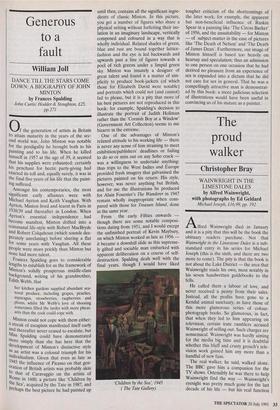Generous to a fault
William Joll
DANCE TILL THE STARS COME DOWN: A BIOGRAPHY OF JOHN MINTON by Frances Spalding John Curtis! Hodder & Stoughton, £25, pp.271 Of the generation of artists in Britain to attain maturity in the years of the sec- ond world war, John Minton was notable for the prodigality he brought both to his painting and to his life. When he killed himself in 1957 at the age of 39, it seemed that his supplies were exhausted: certainly his penchant for hectic party-giving had exacted its toll and, equally surely, it was in the final five years of his life that the paint- ing suffered.
Amongst his contemporaries, the most significant early alliances were with Michael Ayrton and Keith Vaughan. With Ayrton, Minton lived and learnt in Paris in 1938/39 and thereafter in London. When Ayrton's essential independence had become manifest, Minton drifted into a Communal life-style with Robert MacBryde and Robert Colquhoun (which sounds des- perately unrelaxing) before sharing a flat for some years with Vaughan. All these People were more prickly than Minton. but none had more talent.
Frances Spalding goes to considerable lengths to establish for us the framework of Minton's solidly prosperous middle-class background, writing of his grandmother, Edith Webb, that
her kitchen gardens supplied abundant sea- sonal produce, including grapes, peaches, asparagus, strawberries, raspberries and plums, whilst Mr Webb's love of shooting sometimes filled the larder with more pheas- ants than the cook could cope with.
Minton could not cope with them either: a streak of escapism manifested itself early and thereafter never ceased to escalate, but Miss Spalding could have demonstrated more simply than she has here that the development of Minton's distinctive style as an artist was a colossal triumph for his Individualism. Given that even as late as 1945 the influence of Picasso on that gen- eration of British artists was probably akin to that of Caravaggio on the artists of Rome in 1600, a picture like 'Children by the Sea', acquired by the Tate in 1987, and Perhaps the best picture he had painted up
until then, contains all the significant ingre- dients of classic Minton. In this picture, you get a number of figures who share a physical setting without forfeiting their iso- lation in an imaginary landscape, vertically composed and coloured in a way that is wholly individual. Related shades of green, blue and rust are bound together lattice- fashion and the eye is led backwards and upwards past a line of figures towards a pool of rich greens under a limpid green sky. Minton was innately a designer of great talent and found it a matter of sim- plicity to produce book-jackets (of which those for Elizabeth David were notable) and portraits which could not (and cannot) fail to please, but it is a pity that more of his best pictures are not reproduced in this book: for example, Spalding's decision to illustrate the portrait of Judith Hollman rather than the 'Cornish Boy at a Window' (Government Art Collection) seems to me bizarre in the extreme.
One of the advantages of Minton's relaxed attitude to his working life — there is never any sense of him straining to meet exhibition/publishers' deadlines or failing to do so or miss out on any Soho crack was a willingness to undertake anything: thus trips to the West Indies and Europe provided fresh imagery that galvanised the pictures painted on his return. His style, however, was never anything but British, and for me the illustrations he produced for Alain Fournier's The Wanderer in 1947 remain wholly inappropriate when com- pared with those for Treasure Island, done in the same year.
From the early Fifties onwards — though there are some notable composi- tions dating from 1951, and I would except the unfinished portrait of Kevin Maybury, on which Minton worked as late as 1956 — it became a downhill slide as this supreme- ly gifted and sociable man embarked with apparent deliberation on a course of self- destruction. Spalding deals well with the final years, though I would have liked
`Children by the Sea', 1945 ( The Tate Gallery)
tougher criticism of the shortcomings of the later work; for example, the apparent but non-beneficial influence of Ruskin Spear in a painting like The Circus Barker' of 1956, and the unsuitability — for Minton — of subject-matter in the case of pictures like 'The Death of Nelson' and 'The Death of James Dean'. Furthermore, our image of Minton himself is based too heavily on hearsay and speculation; thus an admission to one person on one occasion that he had derived no pleasure from an experience of sex is expanded into a dictum that he did not care for sex in general. That he was a compellingly attractive man is demonstrat- ed by this book: a more judicious selection of illustrations would have been useful in convincing us of his stature as a painter.


















































 Previous page
Previous page